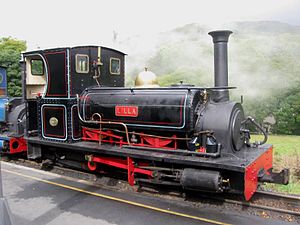Lilla (Quarry Hunslet)
| Lilla | |
|---|---|
|
Lilla in Beddgelert train station, September 2011
|
|
| Manufacturer: | Hunslet |
| Year of construction (s): | 1891 |
| Type : | B n2t |
| Gauge : | 591, 578, 597 mm |
| Width: | 1,854 mm |
| Total wheelbase: | 1,372 mm |
| Service mass: | 10.92 t |
| Friction mass: | 10.92 t |
| Driving wheel diameter: | 660 mm |
| Cylinder diameter: | 216 mm |
| Piston stroke: | 356 mm |
| Boiler overpressure: | 89.57 N / cm² |
| Grate area: | 0.33 m² |
| Radiant heating surface: | 2.04 m² |
| Tubular heating surface: | 15.9 m² |
| Water supply: | 1 m³ |
| Train brake: | Suction air brake (retrofitted on the FR) |
The Lilla locomotive , built by Hunslet , is a tank locomotive with a B wheel arrangement from 1891. It is now part of the Ffestiniog Railway .
history
Lilla was built in 1891 with work number 554 for the Cilgwyn slate quarry in Wales , where it was used for traffic between the processing workshops and the spoil heap. From 1923, the Cilgwyn quarry was connected to the Welsh Highland Railway via a neighboring quarry and an inclined elevator ( Bremsberg ) , which was used to transport the slates. This is how Lilla left the quarry after being sold to the Penrhyn quarry in 1926 .
In the Penrhyn quarry, the locomotive was thoroughly refurbished and from 1928 onwards, initially for a few weeks in the harbor, later mainly in the quarry itself. It was not until 1934 that the gauge was reduced from 591 to 578 mm, the "official" gauge of the Penrhyn quarry . In 1955 Lilla was shut down after a failed boiler test.
In 1963 the locomotive was bought by a private person. Some parts were already missing and had to be bought back together over the next few years, e.g. B. the coupling rods were used for the Prince locomotive of the Ffestiniog Railway, which has the same wheelbase. In 1972 Lilla was operational again and was shown at a steam exhibition. She spent the rest of the season at the newly opened Knebworth Park and Winter Green Railway . Over the next few years it was used on various other railways, and in 1995 it came to the Boston Lodge Works of the Ffestiniog Railway (FR) for boiler maintenance . Then Lilla stayed with the FR - the Knebworth Park and Winter Green Railway had already been closed in 1990 - and was taken over in 1997 by a group of people connected with the FR.
In 2004, the now 113-year-old boiler had to be replaced and a new, welded boiler was built at the Boston Lodge Works. The original cauldron is one of the oldest preserved Hunslet cauldrons and will be preserved as a museum.
Lilla is too weak to pull scheduled trains, but is used on both the FR and Welsh Highland Railway at special events for short shuttle and special trains and cab rides. Occasionally, the locomotive continues to be a guest on other museum railways, most recently in September 2011 on the Lynton and Barnstaple Railway .
technology
Lilla corresponds in its construction to the typical Quarry Hunslets , i. That is, it is a two-axle tank locomotive with an outer frame, saddle tank , short wheelbase, large overhangs, inclined cylinders and an internal Stephenson control . According to the information in a Hunslet brochure, it can pull 200 t on the flat, 100 t on a slope of 1: 100 and 55 t on a slope of 1:50. The minimum recommended radius is 12.2 m.
Lilla is one of the few Quarry Hunslets only one of which has been built. In the dimensions of the boiler, cylinders and drive wheels, it corresponds to the later built locomotives of the Mills Class of the Dinorwic quarry , but differs from them in the higher-lying driver's cab and a slightly lower overall weight. In addition, the shape of the frame is different: Lilla's is beveled at the ends on the underside, like on the Alice Class locomotives , and the buffer beams do not reach down to the rails. The greater ground clearance thus achieved made it easier to move the locomotive over the inclined lifts that connected the levels of the quarries.
literature
- Cliff Thomas, Quarry Hunslets of North Wales, Oakwood Press, 2004, ISBN 0-85361-575-6
Web links
- Article about Lilla at Festipedia (English)

